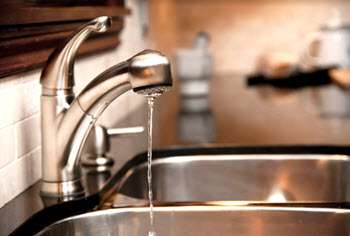Experiencing low water pressure specifically in your kitchen sink, while the rest of your home enjoys a normal flow, can be incredibly frustrating. It disrupts daily routines, making tasks like washing dishes and preparing meals significantly more time-consuming. This localized problem often signals a specific issue within the kitchen sink’s plumbing, rather than a widespread problem affecting the entire house. Understanding the common causes of this isolated low water pressure situation is the first step towards finding a solution and restoring the convenience you expect. Let’s explore some possible culprits behind this annoying kitchen sink predicament.
Common Causes of Low Water Pressure in the Kitchen Sink
Several factors could contribute to weak water flow in your kitchen sink. It’s helpful to investigate these potential causes systematically to pinpoint the exact problem.
- Aerator Clogging: The aerator, located at the tip of your faucet, mixes air with water to create a smooth, even flow. Mineral deposits, sediment, and debris can accumulate in the aerator, restricting water flow and causing low water pressure.
- Faucet Cartridge Issues: Over time, the faucet cartridge, which controls water flow and temperature, can become worn or damaged. This can lead to reduced water pressure and even leaks.
- Supply Line Obstructions: The supply lines that connect the faucet to the main water pipes can become kinked, bent, or clogged with debris. These obstructions can significantly reduce water flow to the faucet.
- Angle Stop Valve Problems: The angle stop valves located beneath the sink control the water supply to the faucet. If these valves are not fully open or are corroded, they can restrict water flow.
- Corroded or Old Pipes: In older homes, galvanized steel pipes can corrode internally, reducing the diameter of the pipe and restricting water flow. This is less common than the other causes, but still a possibility.
Troubleshooting and Solutions
Once you understand the potential causes, you can begin troubleshooting the issue. Here are some steps you can take:
Checking and Cleaning the Aerator
- Unscrew the aerator from the faucet.
- Disassemble the aerator components.
- Clean each component thoroughly with a brush and vinegar to remove mineral deposits.
- Rinse all parts with clean water.
- Reassemble the aerator and screw it back onto the faucet.
- Test the water pressure.
Inspecting the Faucet Cartridge
If cleaning the aerator doesn’t solve the problem, the faucet cartridge may be the issue. This often requires replacing the cartridge. Consulting a plumber is recommended, especially if you are not comfortable with plumbing repairs.
Examining the Supply Lines and Angle Stop Valves
Check the supply lines under the sink for any kinks or bends. Straighten them out if necessary. Also, ensure that the angle stop valves are fully open. If they are corroded, consider replacing them.
When to Call a Plumber
If you have tried the above troubleshooting steps and are still experiencing low water pressure in your kitchen sink, it may be time to call a professional plumber. They can diagnose more complex issues, such as problems with the main water line or internal pipe corrosion. Remember, addressing plumbing problems promptly can prevent further damage and save you money in the long run.
PREVENTATIVE MEASURES
To avoid recurring issues with low water pressure in your kitchen sink, consider implementing some preventative measures. These simple steps can help maintain optimal water flow and prevent future headaches.
– Install a Water Filter: A whole-house water filter or a filter specifically for your kitchen sink can help remove sediment and minerals from the water supply, reducing the likelihood of aerator clogging and pipe corrosion.
– Regularly Clean the Aerator: Make it a habit to clean your kitchen sink aerator every few months. This will prevent mineral buildup and maintain consistent water flow.
– Flush Your Water Heater: Sediment can accumulate in your water heater and eventually affect water pressure throughout your home, including the kitchen sink. Flushing your water heater annually can help prevent this.
– Inspect Plumbing Regularly: Periodically check under your sink for any signs of leaks, corrosion, or kinks in the supply lines. Addressing these issues early can prevent more significant problems down the road.
LONG-TERM SOLUTIONS FOR PERSISTENT LOW WATER PRESSURE
If you’ve tried all the troubleshooting steps and preventative measures and are *still* struggling with low water pressure specifically in your kitchen, it might indicate a more significant underlying issue that requires a more permanent solution. Sometimes, band-aid fixes simply aren’t enough.
PIPE REPLACEMENT
In older homes with galvanized steel pipes, corrosion can be an ongoing problem. Replacing these pipes with copper or PEX piping can significantly improve water pressure and overall water quality. This is a larger project, but it can be a worthwhile investment in the long run.
WATER PRESSURE BOOSTER PUMP
If the overall water pressure in your home is generally low, a water pressure booster pump can increase the pressure to a more satisfactory level. This pump is installed on the main water line and boosts the water pressure throughout the entire house, including the kitchen sink. Be sure to consult with a plumber to determine if a booster pump is the right solution for your specific situation. They will ensure it is properly sized and installed to meet your needs.
Addressing low water pressure proactively will not only improve your kitchen experience but also potentially prevent more costly plumbing repairs in the future. Remember to prioritize safety and consult with qualified professionals when dealing with plumbing issues that are beyond your expertise. By taking these steps, you can ensure a consistent and reliable water supply to your kitchen sink for years to come.







